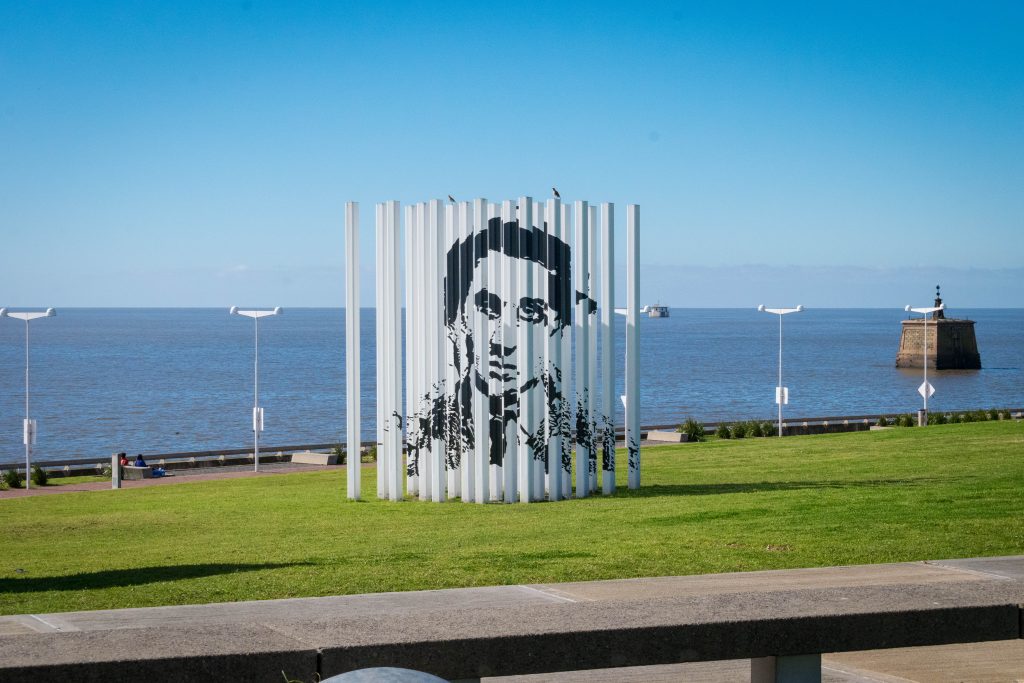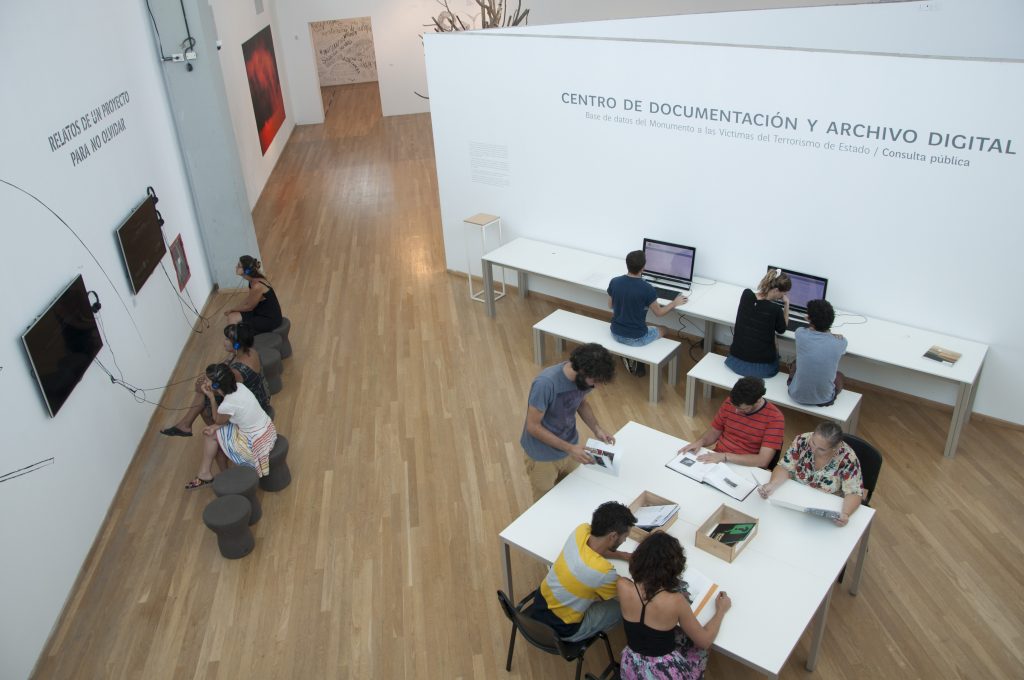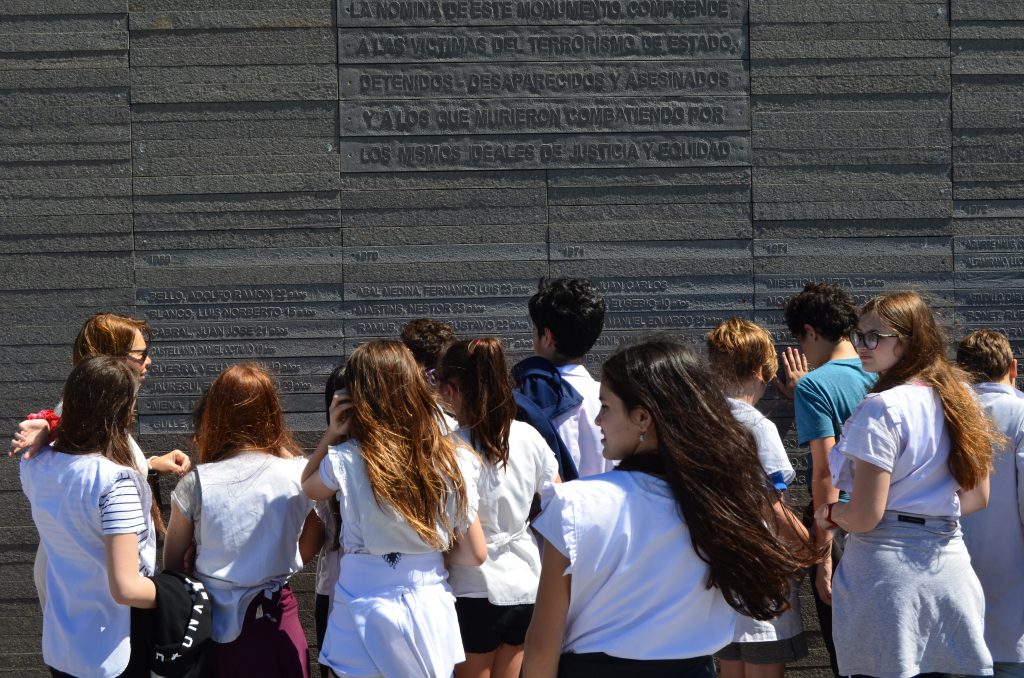Picture: Mothers’ day performance at the Park of Memory, 2020
Nora Hochbaum
General Manager of the Parque de la Memoria – Monumento a las Victimas del Terrorismo de Estado Buenos Aires, Argentina
Writing in times of pandemic about the experience of the Parque de la Memoria – Monumento a las Victimas del Terrorismo de Estado (Park of Memory – Monument to the Victims of State Terrorism) perhaps raises again the issue of how we work on historical memory and how we construct the future. At times when reality challenges us and we know little about what awaits us as a community, as a country and as global citizens, it is even more important to remember. We must learn from our experiences and construct collective memory that brings us together and gives us the strength and tools we need to endure the challenges and give hope to the next generations.
Human rights organisations in Argentina know a lot about convictions, the investment of energy, tenacity and, above all, love. For 42 years, the Madres y Abuelas de Plaza de Mayo (Mothers and Grandmothers of the Plaza de Mayo) have been an example of the fight to construct a country that defends historical memory, truth and justice. The park was built on the foundations of this struggle. It was not conceived to heal wounds, but is a place for remembrance, homage, testimony and reflection.
When the state commits crimes against its citizens, without any control and through an organised system, we call it state terrorism. This happened in Argentina and Latin American in the 1970s and at the start of the 1980s. Thousands of people disappeared or were assassinated. They were tortured, illegally detained and even today their whereabouts is unknown. They were stripped of their identity, buried as “no name” in shared graves or tossed into the waters of La Plata River. Many others were forced into exile.

The unprecedented crimes committed by Argentinian state terrorism include the establishment of over 200 clandestine detention centres, and the confiscation and theft of over 500 babies and children who were deprived of their identity, their family and their history. Today, now that our Grandmothers’ association has recovered and restored the identity of 130 grandchildren, we know that the path of “never again” is long, that there is still far to go, and that nobody can bring loved ones back to their families or return missing citizens to the country. However, the creation of spaces like this one contributes to teaching about and the permanence of their legacy and memory.
In July 1998, when Buenos Aires City Legislature approved by law the construction of the park and the monument, some laws were still in force in Argentina. These were the Law of Due Obedience and the Full Stop Law, which prevented those responsible for state terrorism crimes from being tried. The laws of impunity were declared unconstitutional by the Argentinian Supreme Court of Justice and void by the Congress of the Nation in 2003. Over the years, this made it possible to put on trial hundreds of people who were guilty of genocide, repression and appropriation, members of the armed and security forces, under the concept of crimes against humanity.

The park project was an unprecedented experience of participation: human rights organisations, the University of Buenos Aires and the Executive and Legislative Powers of the City worked together to define this space. From the outset, the project had some innovative and creative aspects for the period, particularly the inspiring perspective without limited horizons. Today, the park combines the power of the Monument to the Victims of State Terrorism, which lists the names of missing and assassinated people, with a public art programme comprised of over ten large-scale sculptures, the programming of contemporary art exhibitions, a solid education project and the creation of a public database, among other aspects.
Another of the initial, innovative achievements was to give this project a permanent legal and administrative framework, in order to maintain public policies of human rights. In institutional terms, the creation of a Board of Management comprised of human rights organisations, the University of Buenos Aires and the Executive Power of the City of Buenos Aires guarantees these public policies. The consensuses and agreements that were worked on at length were key from the outset to ensure that this space had a clear, permanent future, regardless of the political situation or supporters of the time. The Park of Memory was declared a National Monument and Heritage of Buenos Aires, which firmly consolidated its position in the urban fabric of our city.
This operational model enables us to consider and conceive management tools and policies of action that are designed to incorporate and produce new sensations and perspectives on all expressions of art, education and recreation, and the use of the public space, as well as to expand and include programmes and actions on the new rights and demands that need to be resolved in our society. Clearly, nothing can heal the wounds, but today this space in an emblematic project dedicated to memory. It is considered one of the first and most singular memorials of state terrorism in Latin America.


Along with the monument, a public database was created that contains information about the life and circumstances of the disappearance and/ or assassination of each of the people named on the monument. This information is complemented by digital documentation, such as photographs and press notes. The repressive action of state terrorism was characterised by its secrecy and complete concealment of information about the victims, for example, their names, figures, dates and destinations. Consequently, the database is not definitive or closed: it is under permanent construction and continuously updated. It is open to future entries that arise from other documentary sources, information generated through the reopening of trials for crimes against humanity, and new accusations against the Argentinian State.
We consider that memory is a collective process that is constructed over time. That is why, since the foundation of the park and monument, art has been considered vital to encourage reflection and encounters. The park’s art department is in charge of implementing the plan for constructing new sculptures and drawing up the programme of visual art exhibitions that are shown in the PayS Gallery (Present Now and Forever). The decision to include art in the remembrance project recognises that art provides a form of reflection that is critical but sensitive, that can challenge routine memory and prompt a dialogue with visitors that involves not only their intellect, but all their senses.
As the visual art exhibitions are conceived as social spaces for thinking and debate, the exhibition programme proposes a dynamic link between past and present. It aims to question, from a poetic perspective, various topics associated with the memory of state terrorism, human rights and the tensions between art, history and politics. In terms of curatorial practice, these issues are not tackled literally or by clinging to factual history, but by resorting to various formats and strategies to enable critical, plural interpretations of the projects and works that are presented, and to associate the past with problems that are still relevant today.
The link with art is also what has made the park one of the most visited spaces by schools and groups of children and adolescents in the City of Buenos Aires. The education department organises ongoing guided visits, workshops and special activities that tackle current topics relating to human rights, to build bridges between the past and the present. The shaping of identity, freedom of expression and diversity are topics that are always on the agenda, to generate spaces for reflection and work among young people and thus strengthen the construction of critical interpretations of reality.
To transmit is to meet with others because the challenges of democracy are largely at play in the public space. Therefore, the idea is to create meeting places, to give meaning to the collective, to find common spaces without specific forms, prejudices or preconceptions. This concept of permanent, dynamic construction and alert minds has enabled us in these twenty-two years to form and consolidate a large network of relations in our community, with our students, artists, activists, teachers and researchers, as well as strong ties with other countries and communities.
All these relations are what constitute the impetus to continue to construct a suitable strategy for work, production and action. Each one of the challenges that has been set involves continuing to work as a team to think about, imagine and develop a place that honours the work carried out by preceding generations and is always open to the future generations. Today, it is clear that new and challenging questions are arising about almost everything, with few, uncertain answers. However, I am certain that when I look at the work we do and the commitment of each person who in one way or another constitutes the park, we will find new ways to connect, to hug, to reflect together and accompany each other in the most difficult times, to construct a “new normal” that is fairer and more caring.
